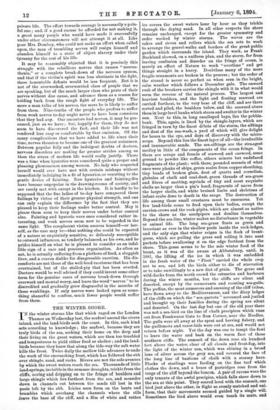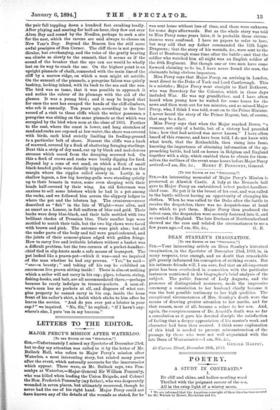THE WINTER SHORE.
TN the winter storms like that which raged on the London Thames on Wednesday last, the seafowl ascend the rivers inland, and the land-birds seek the coast. In this, each kind acts according to knowledge ; the seafowl, because they are truly birds of the sea, seeking their home on the deep and their living on the great waters, which are then too troubled 'and tempestuous to yield either food or shelter ; and the land- birds because they know that along the tide-way the salt water kills the frost. Twice daily the mellow tide advances to undo the work of the encroaching frost, which has followed the ebb -over shingle, sand, and rocks. Rivers are not the sole avenues by which the sweet waters reach the sea. Thousands of little land-springs, invisible in the summer droughts, trickle from the .cliffs, oozing and dripping on to the fringe of boulders and large shingle which lies farthest from the sea, and meander down in channels cut between the sands till lost in the pools left by the ebb. Icicles soon form on the bents and brambles which overhang the channels where the rills leave the base of the cliff, and a film of white and rotten ice covers the sweet waters hour by hour as they trickle through the drying sand. In all other respects the shore remains unchanged, except for the greater symmetry and order worked by winter storms. The waves are the rakes and sieves and rollers which the sea sets to work to arrange the gravel-walks and borders of the great public garden which surrounds the island. They work, as Frank Buckland showed, on a uniform plan, and the storm, far from leaving confusion and disorder on the fringe of ocean, is merely an effort of Nature to work " overtime " and get things straight in a hurry. Doubtless many of the more fragile ornaments are broken in the process ; but the order of the strand is never so perfect as when seen in the bright, calm weather which follows a December gale. The onward rush of the breakers carries the shingle with it in what would seem the reverse of the natural process. The largest and heaviest boulders, and the light and floating seaweed are carried furthest, to the very base of the cliff, and are there sorted and piled, the boulders below, and the seaweed above them in large level banks which steam and swelter in the winter sun. Next to this, in long escalloped bays, lies the pebble- bank. This, again, is lined by the shingle-layers, which are fringed in turn by the finest debris of the storm, the siftings and dust of the sea-wash, a yard of which will give delight for hours to the eye, and days of discovery with the micro- scope. Beyond this lies the finest layer of all—the irreducible and innumerable sands. The sea-siftings are the strangest medley in little of the components of the ocean fringe. In them are scraps and fronds of seaweed and oarweed, some ground to powder like coffee, others minute but undefaced fragments of the plant; with these, pounded morsels of what once were planks of ships, green scales from copper sheathing, tiny beads of broken glass, dust of quartz and cornelian, globules of chalk and coal-dust, green threads of sea-grass and fibres of matting, myriads of tiny and most exquisite shells no larger than a pin's head, fragments of nacre from the larger shells, and white bruised limbs and skeletons of infant crabs done to death in the surge. The destruction of life among these small crustacea must be enormous. Yet few land-birds come to feed upon their bodies, except the carrion-crows and the rock-pipits, which are almost as native to the shore as the sandpipers and dunlins themselves. Beyond the sea-line, winter makes no disturbance in vegetable or animal life. The long sea-grass floats as green and luxuriant as ever in the shallow pools inside the rock-ledges, and the only sign that winter reigns is the flock of brent- geese, which are pulling the grass and rolling it into neat packets before swallowing it on the edge furthest from the shore. This grass seems to be the sole winter food of the brent, as it was of the swans at Abbotsbury, until, in 1881, the lifting of the ice in which it was embedded in the fresh water of the " Fleet " carried the whole crop out to sea, and left the birds either to die of starvation or to take unwillingly to a new diet of grain. The geese and wild-ducks from the north crowd the estuaries and harbours daring the winter months, but the cliffs are silent and deserted, except by the cormorants and roosting sea-gulls. The puffins, the most numerous and amusing of the cliff tribes, have flown away to the Mediterranean, and the dizzy ledges of the cliffs on which the " sea-parrots " screamed and jostled and brought up their families during the spring are silent and deserted. On the last day but one of the old year there was not a sea-bird on the line of chalk precipices which runs out from Freshwater Gate to Sun Corner, near the Needles. The gulls were all away at the sprat and herring fishery, and the guillemots and razor-bills were out at sea, and would not return before night. Yet the day was one to tempt the fowl to leave the water and bask on the warm face of these southern cliffs. The summit of the down rose six hundred feet above the water, clear of all clouds and frost-fog, into the light of the winter sun, which was shining in a broad lane of silver across the grey sea, and covered the face of the long line of bastions of chalk with a steamy haze. Flocks of starlings were feeding on the fine turf which clothes the down, and a brace of partridges rose from the verge of the cliff beyond the beacon. A pair of ravens were the only tenants of the awful precipice, which falls sheer down to the sea at this point. They soared level with the summit, one bird just above the other, in flight so evenly matched and uni- form, that their movements seemed guided by a single will. Sometimes the bird above would even touch its mate, and
the pair fall toppling down a hundred feet croaking loudly. After playing and soaring for half-an-hour, they flew out over
Alum Bay and round by the Needles, perhaps to seek a site for the nest, which the ravens are said always to choose on New Year's Day. Beyond the Beacon lies the still more awful precipice of San Corner. The cliff there is not perpen- • dicular, but overhanging, and the voice of the gently heaving sea climbs so slowly to the summit, that it seems as if the sound of the breaker that the eye can see would be wholly lost on its way to reach the ear. On the highest point is an upright pinnacle of chalk, connected with the main line of the cliff by a narrow ridge, on which a man might sit astride. On the summit of the pinnacle, a peregrine falcon was quietly basking, looking inland, with its back to the sea and the sun. The bird was so tame, that it was possible to approach it and notice the colour of its plumage with the aid of the glasses. It was a young bird ; and it may be hoped that for once the nest has escaped the hands of the cliff-climbers, who rob it annually. Ten years ago, according to the last record of a visit to these cliffs which the writer possesses, a peregrine was sitting on the same pinnacle as that which was occupied by the bird when seen at the close of 1893. Further to the east, where the coast is lower, and long stretches of sand and rocks are exposed at low-water, the shore was covered with birds, each kind strictly limiting its feeding-ground to a particular belt of shore. Nearest the cliffs was a bank of seaweed, covered by a flock of chattering foraging starlings. Next this a strip of dry sand, cut up by black and malodorous streams which oozed from the decaying seaweed bed. On this a flock of crows and rooks were busily digging for food. Beyond lay a zone of wet sand, on which a flock of small black-headed gulls were daintily tripping up and down on the margin where the ripples rolled slowly in. Lastly, in a shallow lagoon, a few big herring-gulls were standing quietly up to their breasts in water, some even sleeping with their heads half-covered by their wing. An old fisherman was anxious to sell some lobsters which he had in a pot among the rocks, and we followed him across the slippery ledges to where the pot and the lobsters lay. The creatures—never described as " fish" in the Isle of Wight—were alive, and as smart as a Lancer, in full uniform of blue and gold. Their backs were deep blue-black, and their tails mottled with two brilliant shades of Prussian blue. Their smaller legs were mottled to match their tails, but the two big claws were faced with brown and pink. The antennae were pink also ; but all the under parts of the body and tail were pearl-coloured, and the joints of their armour-plates edged with golden fringe. How to carry live and irritable lobsters without a basket was a difficult problem, but the two corners of a pocket-handker- chief tied in slip-knots made a safe means of transport. The pot looked like a prawn-pot—which it was—and we inquired .of the man whether he had any prawns. "Yes," he said- " one—a beauty ; " and taking off his cap he exhibited an .enormous live prawn sitting inside ! There is almost nothing which a sailor will not carry in his cap ; pipes, tobacco, string, fishing-hooks, and bait, are all accommodated there,—perhaps because he rarely indulges in trouser-pockets. A man•of- wax's-man has no pockets at all, and disposes of what sur- plus property he cannot carry in his cap, inside the loose front of his sailor's shirt, a habit which sticks to him after he leaves the service. "And do you ever put a lobster in your caps P" we inquired. "No, Sir," he replied ; " if I havn't any- where's else, I puts 'em in my buzzom."











































 Previous page
Previous page